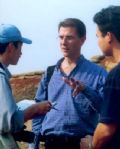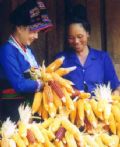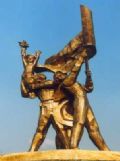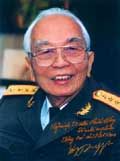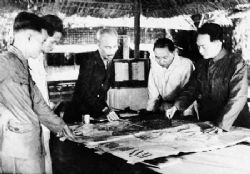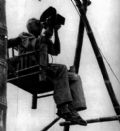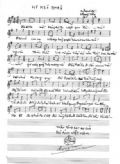For months, prior to the 50th anniversary of the Dien Bien Phu Victory (May 7, 1954 - May 7, 2004), quite a few relics of the former Dien Bien Phu battlefield, such as the At has b1 Hill, the bunker of the French General De Castries - Commander of the French army in the field, and the Muong Phang headquarters of the Vietnamese General Vo Nguyen Giap, have been repaired and renovated. The grandiose Dien Bien Phu Victory Monumeneen erected on the top of the D1 Hill. Numerous groups of war veterans and visitors have revisited this battlefield.
On the top of the A1 Hill, which was called Eliane by the French, we met former soldiers of the heroic Capital's Regiment under the Vanguards' Division 108. The oldest veteran was 80-year-old Nguyen Van Ngu with white hair and a beard. He wore a uniform with many red medals pinned on the chest. He said proudly: "We are soldiers of this former battlefield. The State was willing to pay for us to come here by plane, but we wanted to go by car to see how the paths through which we had operated have changed".
Pointing to a deep tunnel-shaped area, the old veteran said: "I still remember this is the place where my unit dug a tunnel to plant explosives, nearly one tonne in weight, that blew up a strong and dangerous position of the enemy". His wife, who was also a militia-woman of the Capital Defense Squad during the resistance war, listened to her husband attentively, seeming to be lost in the flow of the memories. That was the place where her husband and other soldiers rushed forward to occupy one of the most important strategic positions of the enemy. At this place, many of his comrades-in-arms laid down their lives. "In the first offensive, half of our regiment died," he recalled. "We encouraged one another to resolutely make the second offensive to occupy the hill". Passing through the gate of the martyrs' cemetery, Ngu was speechless with emotion. More than 3,000 soldiers laid down their lives on this land, but so far only 600 remains have been gathered in the cemetery. They were heroes like To Vinh Dien, who used his body to chock a heavy artillery gun to prevent it from rolling down the slope, Be Van Dan who used his body as a gun's tripod for his comrade-in-arm to fire at the enemy, Phan Dinh Giot who stopped an enemy gun loop-hole with his body, and many unknown heroes and martyrs.
Ngu sadly burned incense joss sticks for martyr Phan Dinh Giot and knelt by the side of his grave for a long time, seemingly he had many things to say to his old comrade-in-arms. His wrinkled eyes were full of tears.
Not only Vietnamese veterans, but also foreign visitors were the guests of Dien Bien area. On A1 Hill we met Bill Tod, Director of the British Hanoi-based Save the Children Fund, who came to Dien Bien to implement a project of comprehensive care and development for the children in Muong Lay District. Asked about his knowledge of the land where he was standing, Bill Tod said ebulliently: "Luckily I am here on the occasion of the 50th anniversary of the Dien Bien Phu historic victory. I know a lot about Dien Bien Phu through historical books and newspapers. I also know that the French did not believe that Vietnam could carry the heavy weapons and bring troops to this hollow area". He seemed rather surprised at Dien Bien Phu area, which was much more modern and convenient than what he had imagined before.
We were also amazed at the changes of this area. A young city is flourishing. It is a city with buildings mixing with mountains and hills surrounded by the immense Muong Thanh field.
According to the decision made at the 4th session of the 11th National Assembly Legislature in November 2004, Lai Chau Province was separated into Dien Bien and Lai Chau Provinces. That was an important event creating a new position and strength for both provinces to further develop to keep pace with the development of other provinces and cities in the country, while preserving the brave Dien Bien Phu tradition. Under the plan, Dien Bien Province will have three economic zones with their
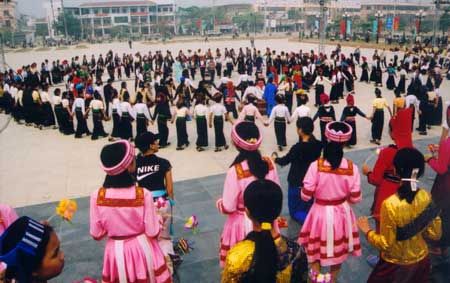 Dancing together at the victory festival. |
own specific characteristics. The Muong Cha economic zone is the re-settlement area for the Son La hydro-electric power project, cattle raising development, afforestation and land clearance for the wet-rice fields. The Song Da agricultural, forestry and ecological economic zone specializes mainly in growing the protective forests and long-term industrial crops, such as Shan tuyet tea, cardamon and other trees to provide raw materials for Lai Chau Paper Mill and for forest product processing. The dynamic economic axis at Highway 279 produces food and foodstuff and forms a trade and tourist centre for the whole province. Dien Bien has a long borderline and is potentially favourable for the development of a border-gate economy. It is an international tourist route from the old capital of Luong Phrabang of Laos to Vietnam, through the Muong Loi border gate and from the A Pa Chai border gate to the Chinese Province of Yunnan and the northeast area of Myanmar. In 2003, the service sector, with tourism as a key part, accounted for 36.65% of the provincial GDP, equivalent to the combined share of the agricultural, forestry and fishery sectors. The Province has a precious asset of cultural villages, which are the favourite destinations for foreign visitors.
Apart from the cultural treasure, its ecological tourist sites, such as Pa Khoang Lake, Huoi Pha, Thanh Luong hot spring, U Va Lake, Pu Nhi mountainous resort and Na Ngam Lake have been developed, promising a flouring future. Surely, the year 2004 will mark a big leap forward for Dien Bien Province.
|
DIEN BIEN PROVINCE - Area: 9,555 sq. km. It is the upper area of three big rivers including Da, Ma and Nam Rom Rivers. - Population: Approximately 440,000 people (data 2003) of 18
ethnic groups with the Thai being the largest (about 40.4%), the
H'Mong (28.8%), the Kinh (19.7%), Kho Mu (3.2%) and others, such as
the Dao, Ha Nhi, Hoa, Khang and La Hu. -nbsp;Climate:
Mountainous, tropical monsoon. Cold and less rain in winter, hot
with much rain and less influenced by storms in summer. Average
temperature: 21-23oC. Average rainfall: 1,700-2,500 mm. Average
humidity: 83-85%. |
Story: Duc Anh - Photos: Van Chuc, Ngo Du
Duc Anh - Van Chuc, Ngo Du





